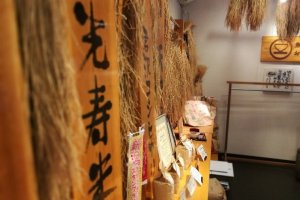Niigata Prefecture is one of the major rice production areas of Japan, and Koshihikari is the most famous rice brand here. If you have an interest in learning about this prefecture's staple crop, head to Okome no Gakkou, a rice museum which is located in Minamiuonuma's Bokushi Street. Along with the opportunity to taste delicious locally grown and processed Koshihikari, visitors are also able to receive knowledge about the processing steps that rice crops go through.
With explanations from one of Japan's rice experts, we were escorted to a rice processing corner which was full of equipment and machines. The expert explained the rice separation methods and the processes of making the best quality rice using various technologies and high-tech equipment.
According to him, in Japan it is very important to differentiate the rice grade so that the value of rice can be determined - and there are several processes that take place before rice can be graded. The first process is to separate small rocks and pebbles from the rice. He took us to a room containing a huge device which was capable of separating almost all the rocks from the rice so that the rice can be processed in the next machine.
After the separation of all the pebbles and rocks, he showed us all the rice grains that were not in good shape. Therefore, the next step was to separate the high-quality rice from the imperfect rice granules. This room had a different machine which was able to perform this task effectively.
The rice obtained from this machine was even but was brown in color. He informed that the brown colored rice was not so appealing to the eyes of many customers, and the rice was required to be polished so that the color could be white. We were taken to another room which contained a machine which was designed to polish these rice grains effectively. The process ended with another device separating all the choppy rice from the package.
Finally, he showed us the rice taste measurement device in this museum. The device was able to measure the grade of the rice after it has been processed. Courtesy of this device, we were able to determine that the Koshihikari rice was either grade A or somewhere below it.
There was also a traditional stove on display used for cooking rice. Cleverly, this stove was able to cook rice with zero waste. The rice grain's skin was used as fuel and the combustion residue from the stove was later used as fertilizer!
Finally, Okome no Gakkou also contained a restaurant! Here we had the opportunity to taste the best rice in Japan and other tasty dishes prepared by the expert chef himself.































